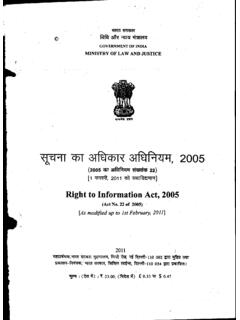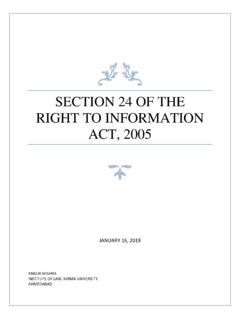Transcription of Disclosure vs. Non Disclosure of Information Under RTI Act ...
1 Disclosure vs. Non Disclosure of Information Under RTI. Act, 2005. By-Nikhil Goel Amity Law School, Amity University, Noida INDEX. 1. Abstract 2. Introduction 3. Disclosure of Information 4. Non Disclosure of Information I. Section 8 of the Right to Information Act, 2005. II. Section 9 in The Right To Information Act, 2005. III. Section 24 in The Right To Information Act, 2005. 5. Conclusion 2. 1. ABSTRACT. The Right to Information Act 2005 has been probably the most discussed law of the recent times. RTI act was passed on 15 June 2005 and came fully into force on 12 October 2005by the Indian Parliament with the basic aim is to provide Information to all the citizens of India from any public authority relating to the administration, operation and decisions, to maintain the transparency and accountability in the working of public authorities.
2 The first RTI. application was filed at a police station in Pune by Shahid Raza Burney. The first RTI. application in Delhi was filed to the office of President about article 370 in Jammu &. Kashmir. Under the provisions of the act any citizen of India may request Information from a public authority, be it a body of Government or instrumentality of state, expeditiously or within 30 days. The focus of the paper is on the Information which can be disclosed and which is exempted Under Right to Information Act 2005. This paper will help in clearing the concept of Section 8, section 9 and section 24 which defines the Information that can be exempted Under the act and section 2(f), 2(i) and 2(j) which defines the Information that can be provided Under the Act and the implementation and interpretation of these two sections by the Central Information Commission.
3 3. 2. INTRODUCTION. In the long history of RTI Act 2005 in India, there have been varied challenges to beat. Since British times, there are several laws that prohibited implementation of right to Information which includes: Section 123 of the Indian evidence Act 1872: No one shall be permitted to give any evidence derived from unpublished official records relating to any affairs of State, except with the permission of the officer at the head of the department concerned, who shall give or withhold such permission as he thinks fit. 1. The Official Secrets Act, 1923: The Official secret Act 1923 is India's anti undercover work act control over from British colonisation.
4 It states clearly that action that involves serving to an enemy state against India. It conjointly states that one cannot approach, inspect, or maybe jump over a prohibited government web site or space. Consistent with this Act, serving to the enemy state are often within the sort of human action a sketch, plan, model of a politician secret, or of official codes or passwords, to the enemy. This law was the most important challenge in the history of RTI Act 2005 in India because it prohibited all public servants from disclosing any Information to the Rule 11 of The Central Civil Services (Conduct) Rules, 1964: No Government servant shall, except in accordance with any general or special order of the Government or in the performance in good faith of the duties assigned to him, communicate, directly or indirectly, any official document or any part thereof or Information to any Government servant or any other person to whom he is not authorised to communicate such document or Information .
5 3. Oath by the Public Servant: Before joining duty, public servant swears that the Information is a state secret. Archives Policy Resolution of 22 December 1972: States that each one document is classified for thirty years and thenceforth solely non-confidential material is obtainable to a restricted vary of individuals. Even unclassified material can't be communicated to anyone outside the govt. without permission. 1. The Indian Evidence Act, 1872 , Bare Act 2. 3. The Central Civil Services (Conduct) Rules, 1964. 4. Rule 9 of The All India Services (Conduct) Rules, 1968: No member of the Service shall except in accordance with any general or special order of the Government or in the performance in good faith of duties assigned to him, communicate directly or indirectly any official document or part thereof or Information to any Government servant or any other person to whom he is not authorised to communicate such document or Information .
6 4. The above specified laws are pointed as the main hurdle in implementing the Right to Information Act 2005. From time to time many private and government institutions have tried to implement the Right to Information Act in India. Various events had happened in the history to implement it which includes to ascertain whether the official Secret act 1923 can be modified so that the more Information can be flowed to the public. It was operated by the Janta government headed by the Morarji Desai in the working group recommended that the Act of 1923 can't be change, it will be retained same. But in 1986 the Supreme court in the case of Mr. Kulwal v/s Jaipur Municipal Corporation said that the Freedom of Speech and Expression provided Under Article 19 of the constitution is useless without Right to Information as without the Information how one can use its freedom of speech and expression.
7 In 1990 V P Singh the Former Prime Minister, National Front Government tried to put forward the RTI. He was the first politician who stressed the importance of the RTI. He tried to enact legislation in 1989-90. But due to lose of the confidence vote in Lok Sabha he was removed from the office in 1990 and the idea of the RTI did not come in action. In 1994. Mazdoor Kisan Shakti Sanghatan (MKSS) take an imitative and started a campaign to bring RTI in legislation to collect Information related to the development works in rural Rajasthan. This movement helps in enacting a law on the Right to Information in 2000 in Rajasthan. In 1995 the social activist formulated a draft Act in a meeting at the LBSNAA, Mussoorie, 1995.
8 In 1996 due to growing demand of the RTI a law was drafted by thr press council of India Under the guidance of its Chairman Justice P B Sawant which was later updated and changed at a workshop and renamed The Press Council NIRD Freedom of Information Act, 1997. In 1997 the Right to Information was first passed in Tamil nadu also in the same year the MP Government also issued orders to implement the Right to Information in 36. departments which was further increased to more than 50 departments. Also in 1997 Right to Information was also enacted in the Goa legislature. In 1998 the MP Government proposed the bill on the Right to Information which was passed by the legislature but it didn't become 4.
9 The All India Services (Conduct) Rules, 1968. 5. law because the governor didn't give his assent. In 1999 the Public Interest Litigation (PIL). was filed before Supreme Court to lift ban on Ministers and to declare Section 5 of Official Secret Act, 1923 unconstitutional. In the urban Affairs Ministry an administrative order was passed on the transparency. In 2000, in parliament the Freedom of Information Bill, 2000 was introduced which was further referred as a Select Committee of Parliament. A law on the Right to Information was passed in 2001 by the NCT Delhi. In both the house of the parliament Freedom of Information Bill, 2000 was passed in December 2002.
10 RTI ordinance was passed by the Maharashtra Government in September 2002 that overwrote the Maharashtra RTI Act, 2000. The Hon'ble Supreme Court of India, in the case of Union of India vs. Association for Democratic reforms and another by its order dated 2nd May, 2002. directed the Election Commission to call for Information on affidavit by issuing necessary order in exercise of its power Under Article 324 of the constitution of India from each candidate seeking election to Parliament or a state legislature as a necessary part of his nomination paper. 5 on 6th January 2003 President of India give his assent to the Freedom of Information Bill and become a law called as Freedom of Information Act, 2002.




